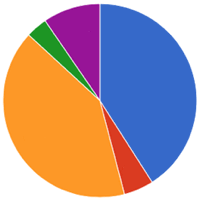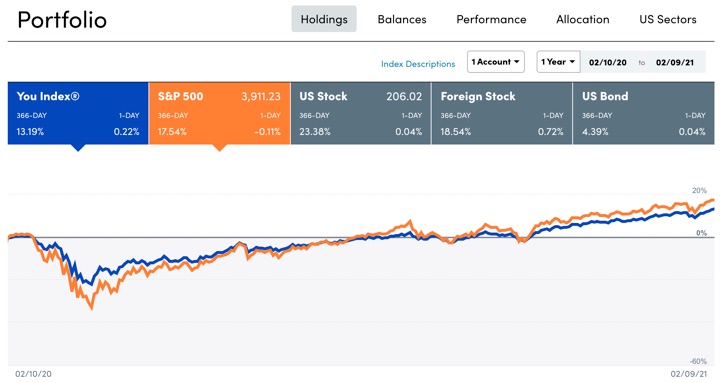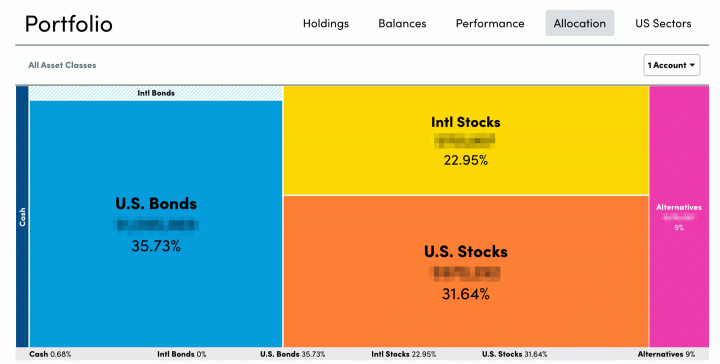
A central idea here is skin in the game, showing what someone really does with their own money. Too often, what the “experts” tell you to do is quite different than what they own themselves. Here’s my current portfolio as of February 2021, including our 401k/403b/IRAs, taxable brokerage accounts, and savings bonds but excluding our house, cash reserves, and a few side investments. I use these updates to help determine where to invest new cash to rebalance back towards our target asset allocation.
Actual Asset Allocation and Holdings
I use both Personal Capital and a custom Google Spreadsheet to track my investment holdings. The Personal Capital financial tracking app (free, my review) automatically logs into my different accounts, adds up my various balances, tracks my performance, and calculates my overall asset allocation. Once a quarter, I also update my manual Google Spreadsheet (free, instructions) because it helps me calculate how much I need in each asset class to rebalance back towards my target asset allocation.
Here are some performance and asset allocation charts, per the “Allocation” and “Holdings” tabs of my Personal Capital account, respectively:


Stock Holdings
Vanguard Total Stock Market (VTI, VTSAX)
Vanguard Total International Stock Market (VXUS, VTIAX)
Vanguard Small Value (VBR)
Vanguard Emerging Markets (VWO)
Vanguard REIT Index (VNQ, VGSLX)
Bond Holdings
Vanguard Limited-Term Tax-Exempt (VMLTX, VMLUX)
Vanguard Intermediate-Term Tax-Exempt (VWITX, VWIUX)
Vanguard Intermediate-Term Treasury (VFITX, VFIUX)
Vanguard Inflation-Protected Securities (VIPSX, VAIPX)
Fidelity Inflation-Protected Bond Index (FIPDX)
iShares Barclays TIPS Bond (TIP)
Individual TIPS securities
U.S. Savings Bonds (Series I)
Target Asset Allocation. I do not spend a lot of time backtesting various model portfolios, as I don’t think picking through the details of the recent past will necessarily create superior future returns. I mainly make sure that I own asset classes that will provide long-term returns above inflation, distribute income via dividends and interest, and finally offer some historical tendencies to balance each other out. I make a small bet that US Small Value and Emerging Markets will have higher future long-term returns (along with some higher volatility) than the more large and broad indexes, although I could be wrong.
While you could argue for various other asset classes, I believe that it is important to imagine an asset class doing poorly for a long time, with bad news constantly surrounding it, and only hold the ones where you still think you can maintain faith through those fearful times. I simply don’t have strong faith in the long-term results of commodities, gold, or bitcoin. (In the interest of full disclosure, I do own tiny bits of gold and BTC, but at less than 1% of net worth.)
My US/international ratio floats with the total world market cap breakdown, currently at ~57% US and 43% ex-US. I think it’s okay to have a slight home bias (owning more US stocks than the overall world market cap), but I want to avoid having an international bias.
Stocks Breakdown
- 43% US Total Market
- 7% US Small-Cap Value
- 33% International Total Market
- 7% Emerging Markets
- 10% US Real Estate (REIT)
Bonds Breakdown
- 33% US Treasury Bonds, intermediate (or FDIC-insured)
- 33% High-Quality Municipal Bonds (taxable)
- 33% US Treasury Inflation-Protected Bonds (tax-deferred)
I have settled into a long-term target ratio of 67% stocks and 33% bonds (2:1 ratio) within our investment strategy of buy, hold, and occasionally rebalance. I will use the dividends and interest to rebalance whenever possible in order to avoid taxable gains. I plan to only manually rebalance past that if the stock/bond ratio is still off by more than 5% (i.e. less than 62% stocks, greater than 72% stocks). With a self-managed, simple portfolio of low-cost funds, we minimize management fees, commissions, and taxes.
Holdings commentary. I should be happy that my portfolio numbers seem to keep going up and up after the March 2020 scare, but instead I am mentally preparing myself for some low future returns over the next decade or so. I’m not making any big moves, but in keeping with my investment plan, I will be selling some US stocks this month as part of normal rebalancing. I remain optimistic that capitalism, human ingenuity, human resilience, and our system of laws will continue to improve things over time.
I’ve been seeing various articles about how to adjust your investing after the Gamestop short squeeze. Given that my holding strategy doesn’t require me to follow any market news at all, I don’t need to do any adjusting! 🙂
Performance numbers. According to Personal Capital, my portfolio ended up about 14% over all of 2020. An alternative benchmark for my portfolio is 50% Vanguard LifeStrategy Growth Fund and 50% Vanguard LifeStrategy Moderate Growth Fund – one is 60/40 and the other is 80/20 so it also works out to 70% stocks and 30% bonds. That benchmark would have a total return of +14.5% for 2020 YTD as of 11/3/2020.
The goal of this portfolio is to create sustainable income that keeps up with inflation to cover our household expenses. I’ll share about more about the income aspect in a separate post.
 The Best Credit Card Bonus Offers – October 2024
The Best Credit Card Bonus Offers – October 2024 Big List of Free Stocks from Brokerage Apps
Big List of Free Stocks from Brokerage Apps Best Interest Rates on Cash - October 2024
Best Interest Rates on Cash - October 2024 Free Credit Scores x 3 + Free Credit Monitoring
Free Credit Scores x 3 + Free Credit Monitoring Best No Fee 0% APR Balance Transfer Offers
Best No Fee 0% APR Balance Transfer Offers Little-Known Cellular Data Plans That Can Save Big Money
Little-Known Cellular Data Plans That Can Save Big Money How To Haggle Your Cable or Direct TV Bill
How To Haggle Your Cable or Direct TV Bill Big List of Free Consumer Data Reports (Credit, Rent, Work)
Big List of Free Consumer Data Reports (Credit, Rent, Work)
Do you allocate for cash in your 67% stock and 33% bond holding ? I hold 70/30 but my 30 in fixed income is inclusive a lot of cash.
I don’t include a year of expenses in my asset allocation, which is roughly 2-3% of the total portfolio. That is my “one year of expenses bucket” so that I always have a year of expenses ready to go. However, I do include the amount of over that in my bonds allocation, even if it is held in cash or CDs. So you might say be true AA is 65/35 instead of 67/33. I don’t really think it makes that much of a difference overall, but that’s how I mentally break it down.
Thanks, so back to my initial question, of your bond portion what percent is cash since you said you have CDs as part of this allocation.
Hmmm… I would say less than a third. My bond allocation includes about 1/3 in TIPs/iBonds and the rest split between Treasury bonds, Muni bonds, and CDs.
Thanks Jonathan! I tend to have more of my fixed in cash but my portfolio is approx 70/30 so when bonds go down in parallel to equities I won’t see the same drop if more is allocated to bonds. Rates will rise at some point, so my philosophy is follow the course with stock growth and hopefully at some point deploy more cash at higher yields. It is more psychological for me knowing my cash can last many years with a 50% drop in equities.